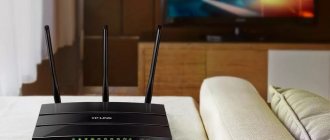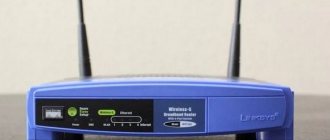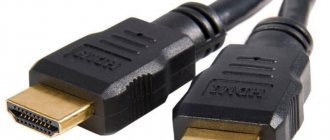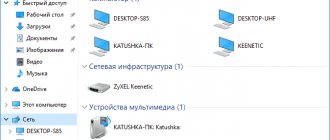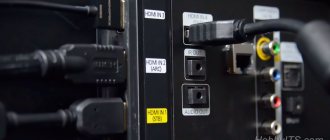Wireless technologies are certainly beginning to take the lead in organizing home and office networks, but they will never replace wired ones, and if this happens, it will not be in the near future. The majority of providers install their wires directly to the client, and only then the work of WiFi routers begins. There are several types of local network cables; they differ in channel capacity, method of connection to the computer, installation method, and others. Let's consider in order how the standards changed, what they were, and what is used today.
What kind of cable is there for a local network?
The choice of conductor is initially always determined by the LAN topology, and the most common are coaxial wires and twisted pair. Fiber optic technologies are now widely used, but this is still a developing standard, used mainly for laying highways over long distances. It is not widely used for connecting the end user. So, there are two types of wire for an Ethernet local network:
- Coaxial - which is a single-core wire with a screen, separated from each other by insulating material or an air gap. Very much resembles a 70 ohm television wire.
- “Twisted pair” - consists of eight wires intertwined in pairs. Each core is marked with a separate color to simplify installation. The colors are fixed and described by specifications and all product manufacturers adhere to these rules.
- Fiber optic or fiber optic - has a very complex design and is quite expensive to install. The signal in it is transmitted in the form of light pulses through special light guides.
In the 90s of the last century, exclusively coaxial wire was used to build local networks, and on its basis such well-known topologies as “bus” and “ring” were developed. A little later, the “star” topology based on twisted pair cables appeared, which is still the most popular and popular architecture for local and global networks. Now it's time to stop and describe each LAN cable used separately.
Twisted pair network cable
The modern and most commonly used cable for local computer networks is twisted pair cable. It is used in both home and administrative local networks with a star topology and has an excellent price/quality ratio. That is, a network cable for a local network of this type has a relatively high data transfer speed in relation to a coaxial cable, and their cost is not high.
A twisted pair network cable for local networks consists of four pairs of monolithic copper conductors, each with a cross-section of 0.4-0.6 mm. The thickness of the core of such a cable is 0.51 mm, taking into account the thickness of the conductor insulation - 0.2 mm. The insulation material used in budget versions of the cable is polyvinyl chloride (designation - PVX), in more expensive cables polypropylene and polyethylene are used (designations - PP and PE) and the highest quality twisted pair cables are made with foamed polyethylene or Teflon insulation.
According to the degree of protection against interference, there is an unshielded cable and a shielded twisted-pair cable. Shielding can be made of wire mesh, aluminum foil/aluminized film, both individual pairs and the entire bundle together.
There are cables with the following types of shielding:
- twisted pair cable (UTP) not protected by any shield at all;
- unprotected by a common shield with pair shielding with foil (U/STP);
- with foil overall shield without shielding individual pairs (FTP);
- with wire screen of each pair and common screen wire (STP);
- with a foil screen for each pair and a common braided screen (S/FTP);
- with double overall screen made of braided wire and foil (SF/UTP).
At the same time, “TP” is present in all designations - this indicates the type of cable - twisted pair (from English - twisted pair). Those letters that go ahead actually indicate the presence/absence of shielding, the type of shielding, as well as the material from which the shielding is made. Thus, the letter U (Unshielded) indicates the absence of screen protection, F (Foiled) - indicates the presence of a common foil general screen insulation of the entire bundle of pairs, S (Shielded) - a screen in the form of wire braiding of each individual pair, and (Screening) - a screen in the form braids of the entire bundle of twisted pairs.
Depending on the length and signal transmission speed, there are different categories of twisted pair (7 in total), while the intended cable for local computer networks starts from the second category, but today cables from category 5E are used starting.
The main difference between the categories of twisted pair cables was previously the number of cores, but starting from the third category and up to the seventh inclusive, all cables have four pairs (8 cores). So, the main difference was the number of turns per unit length, cross-section of the core and resistance, which is a decisive factor on the length and speed of data transfer.
Modern twisted pair cables are used in the following packet data transmission technology standards:
- 100BASE-TX Ethernet;
- 1000BASE-T Ethernet;
- 10GBASE-T Ethernet;
- 40GbE, 100GbE.
The 100BASE-TX standard was implemented using CAT cable. 5 (twisted pair category 5), which was capable of transmitting 100 Mbit/s over two pairs and 1 Gbit over four.
The 1000BASE-T standard is by far the most widespread and is used in many local computer networks. For such networks, the most popular category of cable is used - CAT. 5e, the difference from the previous one is a slightly higher throughput of high-frequency signals and the presence of modifications with two (100 Mbit/s) and four (1 Gbit) pairs.
The 10GBASE-T standard , on which Fast Ethernet and Gigabit Ethernet networks are built, is implemented using CAT cable. 6, which is capable of transmitting data at a speed of 10 Gbit/s over a distance of 55 m. Gigabit Ethernet can also be implemented on CAT cable. 6a and CAT. 7, which increases the data transmission length to 100m. In this case, the seventh category always has full shielding.
The 40GbE and 100GbE standard are the most modern and high-speed packet data technologies that are designed for a Gigabit Ethernet network with a CAT cable. 7a. At a data transfer rate of 40 Gbit/s, the transmission length is 50 m, at 100 Gbit/s – 15 m.
Coaxial cable and connectors used
This type of wire is the oldest of the conductors. This cord has one supporting copper or aluminum core, which is covered with a thick layer of insulating material. Next comes the screen, made in the form of a tape encircling the central core of aluminum or copper. The top outer layer is a sheath that protects the cores from damage, made of polyethylene or polyvinyl chloride. There are several types of such cable used for LAN:
- 10Base 5 is a thick type of conductor, with a cross-section of 12 mm and a total resistance of 50 Ohms for the 8th category and 75 Ohms for the 11th. The data transfer speed does not exceed 10 Mbit/s over distances between end nodes up to 500 meters.
- 10Base 2 is thin, about 6 mm in diameter, most common for organizing home or small office networks. Its resistance is 50 ohms, but the maximum length is 185 meters at a speed of 10 Mbps.
Thanks to good insulation, the signal in the conductor is practically not extinguished, i.e. packets are not lost, and additional algorithms for checking transmitted or received information are not needed. The only drawback is the rather high production cost and low speed, so it was subsequently replaced by “twisted pair”.
“Twisted pair” - types and methods of crimping
LAN cable gets its name from the fact that it consists of eight cores intertwined in pairs. Each core is insulated in a strictly specified color. Polyvinyl chloride or polyethylene is used as an external insulating material that protects the signal from electromagnetic interference. There are several types of such cable:
- UTP (Unshelded Twisted Pair) is an unshielded modification, most often used for laying home or office networks when there is no strong interference with the transmitted signal.
- FTP (Foiled Twisted Pair) is a cable with an additional aluminum foil shield under the outer insulation.
- STP (Shelded Twisted Pair) - in addition to the general screen, it has an additional one for each pair separately.
Twisted pair has 7 categories, and the higher the category number, the more protected the wire is from electromagnetic radiation. For Ethernet networks, Category 5 (CAT5) cable is used, which has a bandwidth of 100 MHz. When installing new facilities, it is recommended to use a more advanced modification of CAT5e for higher frequency signals with a bandwidth of 125 MHz.
Twisted pair is used to create connections at speeds from 100 Mbit/s to 40 Gbit/s, depending on the category and quality of the cable itself and its length between end devices. Typically the segment length should not exceed 100 m.
The wire must have a connector for connecting to network devices. For twisted pair, an RJ-45 connector is used (8P8C - 8 position and 8 contacts). Inside the connector there are special grooves with contacts for each core. There are several options for crimping network cables: forward and reverse (crossover). Straight patch cord is used to connect a computer to a router or switch or to connect active network equipment to each other. Cross is used quite rarely and serves to connect two computers to each other. Currently, almost all manufacturers install “smart” network cards, which do not care about the location of the wires in the connector, but it is advisable to adhere to the standards and arrange the wires as written in the specification. This will help avoid collisions in the operation of the entire network. To make a straight wire for a local network, the cores are arranged in the following order at both ends:
- white-orange;
- orange;
- white-green;
- blue;
- white-blue;
- green;
- white-brown;
- brown.
To make a patch cord for ease of work, special pliers are used - a crimper (or “crimp” in common parlance). The crimper allows you not only to clamp the wire evenly in the connector, but also to properly cut and strip the insulation. In exceptional cases, you can use a flat-head screwdriver or a knife, but then the quality will not be satisfactory. There are connectors that are clamped without a crimper, but they are designed for multi-core soft wires and may not be suitable for standard twisted pair cables.
Types of network cable
In order to increase the speed of data transfer in local networks, the requirements of standards for transmission cables are becoming more and more complex.
What types of Internet cable exist in practice?
A conductor differs from one another in different characteristics. In practice, the following types of network wires are often used:
- twisted pair;
- fiber optic;
- coaxial.
Coaxial cable
The peculiarity of this type of conductor is its wave resistance. Based on this indicator, the quality of the cable is determined. In addition, when choosing a product, you need to pay attention to the material, its technical characteristics, as well as the transmission distance, which affects the signal strength.
You might be interested in this: Features of SIP-3 wire
Type of coaxial wire
Conductors are divided into two categories: thin and thick. The first option should have a diameter of no more than 0.5 cm. This variation is characterized by increased flexibility, as well as rapid signal attenuation. Signal transmission over a short distance is carried out at speeds of up to 10 Mb/sec. The thin cable belongs to the RG-58/U category. Its characteristic impedance is 50 Ohms.
Note! The ability of a conductor to accumulate charge is characterized by inductance and linear capacitance.
Using coaxial cable, you can lay routes for analog video surveillance systems.
twisted pair
To make it possible, after defining each designation, to obtain the necessary information about twisted pair, an international classification of conductors was invented.
Features of twisted pair cable
The classification was based on the AA/BCC value. If “AA” is found, then this indicates the presence of a common screen. The letter "B" represents the individual protection of each pair. The last two characters refer to the twist type. The designation “TR” refers to wires that are twisted in pairs. In the case of "TQ" there is a twist in fours.
Important! The presence of protection is a special characteristic of twisted pair.
Marking will allow you to decipher each value:
- an unprotected pair refers to a type of cable that does not have a protective shield;
- foil pair. The cable has only one shield for all pairs. Its marking is F/UTP;
- unprotected couples. A single screen, which is a braid. The cable is marked with a combination of S/UTP symbols;
- foil protection for couples. Has a common copper screen. Labeling - S/FTP;
- a foil screen protects the vapors. There is no shared screen. Designation U/FTP;
- common foil screen plus braid. Couples without a screen. Marking - SF/UTP;
- foil screen for couples. As a general screen - foil and braid. Recognized by the SF/FTP marking.
Note! This type of Internet wire, like twisted pair, can be connected into a single device network. In this case, you need to maintain their distance. It should not exceed 100 m.
Fiber optic cables
Today, technology has been developed that transmits Internet data at high speed. We are talking about fiber optics. Many people wonder what this means. In fact, through fiber optic wires stretched along the ocean floor, high-speed Internet is transmitted not only through cities, but also across continents.
Definition of fiber optic wires
Advantages of fiber optic cable:
- good throughput data;
- detecting unauthorized access in the most effective way to improve network security;
- noise suppression, sufficient degree of protection against interference;
- fast transfer of information;
- additional options.
You might be interested in this. Features of the VVG cable
Fiber optic cables are divided into two categories: single-mode and multimode. Their distinctive feature is the mode of propagation of light rays in the conductor.
Note! The conductor is terminated using an expensive device. Network installation and repair are quite complex processes. To carry out the work, the help of highly qualified specialists is required. For this reason, fiber optic wire is used in large networks.
Shielded (STP) or unshielded (UTP) network cable
Twisted pair network cables are widely used to transmit information, especially over long distances. Twisting the wire eliminates any magnetic interference that may occur in the wiring. There are two common types of twisted pair wires: STP and UTP.
For your information! S stands for shielded, U for unshielded, and TP for twisted pair for both.
Shielded twisted pair (STP) cable is heavier and more difficult to manufacture. Twisting provides suppression of magnetically induced fields and currents in a pair of conductors. There are different types of copper wires available, with grade 5 being the best and most expensive.
Shielded or unshielded power cables
In terms of usage, UTP is the most common and popular cabling system that operates in most homes, offices due to its lower cost. STP is typically used by large companies in high-performance networks that require maximum throughput.
STP cables are also installed in outdoor environments, where they are exposed to precipitation, structures and equipment that can create additional interference. A good example of this would be the telephone/internet wires that run from the house to the distribution box, all the way to the ISP.
Solid or twisted network cable
The term solid or stranded conductor refers to the actual copper conductors within the cable. Solid may look like an internal conductor presented as a single piece of copper. A stranded wire consists of several thin copper conductors twisted together.
The concept of solid/twisted network wire
Note! Stranded network wires are more flexible. They should be used where the cable will move frequently, such as near workplaces.
A solid network conductor (Solid, in the picture below) is not as flexible, but more durable. It can be used to connect a permanent network, for example, both outdoors and indoors.
You might be interested in this Metal sleeve
Fiber optic cable
Optical fiber is the most advanced technology for transmitting signals over long distances at enormous speed. The difference in signal transmission is that light, rather than electricity, is used as an impulse. Light is transmitted through glass fiber strands and reflected from the inner walls of the conductor. You can simultaneously transmit several signals: they will not intersect or cancel each other. The speed of information transfer over such a cable is limited only by the capabilities of the network cards or adapters themselves. The cable is not subject to interference and is made of non-flammable materials.
The cost of such a cable is relatively low compared to other conductors, but its installation can only be carried out by qualified employees using high-precision and expensive equipment, so it is almost impossible to use it at home. But such a conductor has found wide application for laying highways, because the distances between signal amplifiers can reach hundreds of kilometers. Some providers already provide a service for connecting optical fiber to the home, but end devices are still connected via twisted pair, which is why it is the fundamental standard for organizing a network.
